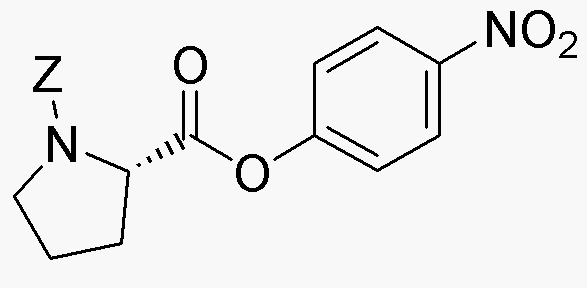Z-L-proline 4-nitrophenyl ester is widely utilized in research focused on:
- Peptide Synthesis: This compound serves as a valuable building block in the synthesis of peptides, enabling researchers to create complex structures for drug development.
- Drug Design: Its unique properties allow for the modification of drug candidates, improving their efficacy and bioavailability in pharmaceutical applications.
- Biochemical Studies: Researchers use it to investigate enzyme mechanisms and protein interactions, providing insights into biological processes and potential therapeutic targets.
- Material Science: The compound is applied in developing new materials, including polymers and coatings, due to its ability to enhance material properties.
- Analytical Chemistry: It is utilized as a reagent in various analytical techniques, aiding in the detection and quantification of other compounds in complex mixtures.
General Information
Properties
Safety and Regulations
Applications
Z-L-proline 4-nitrophenyl ester is widely utilized in research focused on:
- Peptide Synthesis: This compound serves as a valuable building block in the synthesis of peptides, enabling researchers to create complex structures for drug development.
- Drug Design: Its unique properties allow for the modification of drug candidates, improving their efficacy and bioavailability in pharmaceutical applications.
- Biochemical Studies: Researchers use it to investigate enzyme mechanisms and protein interactions, providing insights into biological processes and potential therapeutic targets.
- Material Science: The compound is applied in developing new materials, including polymers and coatings, due to its ability to enhance material properties.
- Analytical Chemistry: It is utilized as a reagent in various analytical techniques, aiding in the detection and quantification of other compounds in complex mixtures.
Documents
Safety Data Sheets (SDS)
The SDS provides comprehensive safety information on handling, storage, and disposal of the product.
Product Specification (PS)
The PS provides a comprehensive breakdown of the product’s properties, including chemical composition, physical state, purity, and storage requirements. It also details acceptable quality ranges and the product's intended applications.
Certificates of Analysis (COA)
Search for Certificates of Analysis (COA) by entering the products Lot Number. Lot and Batch Numbers can be found on a product’s label following the words ‘Lot’ or ‘Batch’.
*Catalog Number
*Lot Number
Certificates Of Origin (COO)
This COO confirms the country where the product was manufactured, and also details the materials and components used in it and whether it is derived from natural, synthetic, or other specific sources. This certificate may be required for customs, trade, and regulatory compliance.
*Catalog Number
*Lot Number
Safety Data Sheets (SDS)
The SDS provides comprehensive safety information on handling, storage, and disposal of the product.
DownloadProduct Specification (PS)
The PS provides a comprehensive breakdown of the product’s properties, including chemical composition, physical state, purity, and storage requirements. It also details acceptable quality ranges and the product's intended applications.
DownloadCertificates of Analysis (COA)
Search for Certificates of Analysis (COA) by entering the products Lot Number. Lot and Batch Numbers can be found on a product’s label following the words ‘Lot’ or ‘Batch’.
*Catalog Number
*Lot Number
Certificates Of Origin (COO)
This COO confirms the country where the product was manufactured, and also details the materials and components used in it and whether it is derived from natural, synthetic, or other specific sources. This certificate may be required for customs, trade, and regulatory compliance.


